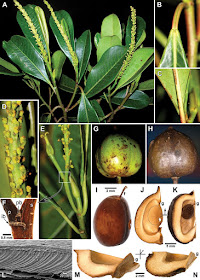 |
| Incadendron esseri K.Wurdack & Farfan |
Abstract
Incadendron esseri K.Wurdack & Farfan, gen. et sp. nov., from the wet sub-Andean cordilleras of Ecuador (Cordillera del Cóndor) and Peru (Cusco, Oxapampa) is described and illustrated. This recently discovered large canopy tree with a narrow elevational range presents an unusual combination of rare morphological characters in Hippomaneae including mucilage-secreting sheathing stipules, conduplicate ptyxis, and large, woody fruits. The broader significance of these characters in Hippomaneae is discussed. The morphology and anatomy of Incadendron were investigated, highlighting its fruit similarities with Guiana Shield endemic Senefelderopsis, and the systematics value of ptyxis variation, which remains poorly studied for the family.
Keywords: Anatomy, ecology, Euphorbiaceae, Hippomaneae, Incadendron, ptyxis, taxonomy
Incadendron esseri K.Wurdack & Farfan, sp. nov.
Diagnosis: Differs from other members of Euphorbiaceae by its combination of exudate of white latex, indument lacking; leaves coriaceous, with marginal glands, ptyxis conduplicate; stipules, large, sheathing, mucilage-secreting, deciduous; inflorescences leaf-opposed, spicate, with solitary pistillate flowers and numerous 3-flowered, glandular staminate cymules; flowers apetalous with 3 sepals, staminate flowers with 3 stamens; fruits large, woody, dehiscent; and seeds dry, ecarunculate.
Etymology: The genus is combined from “Inca” (as Inka, Quechua for “ruler” or “lord”) referring to the indigenous Inca people and pre-Columbian empire that was centered in Cusco and encompassed much of the range of this taxon, and “dendron” (Greek) referring to tree, which is the habit of the plant. Some localities occur near the Trocha Unión, an ancient Inca path. The specific epithet is from “Esser”, the surname of Hans-Joachim Esser (Botanische Staatssammlung München, Germany) and honors this expert on Hippomaneae who has contributed much to our understanding of the tribe and Euphorbiaceae in general.
Distribution, life history, and ecology: Incadendron is known from three well-separated clusters of localities (hereafter referred to as Cóndor, Manu, and Oxapampa populations) on the eastern slopes of the main Andean mountain range in Peru and Ecuador, where it occurs in wet montane forests at 1800–2400 m elevation (Fig. 2). The extent of discontinuity in its range is presently unclear due to the floristically poorly known nature of the intervening areas, and it should be looked for in similar habitats between the three populations. There are minor vegetative differences including leaf apex variation with most tips distinctly acute versus more rarely rounded (i.e., Neill & Kajekai 16620, Monteagudo et al. 16929), and a larger-leafed collection (i.e., Monteagudo et al. 4458). The differences exist within the populations and presently do not suggest differentiation worthy of taxonomic recognition. ....
Kenneth J. Wurdack and William Farfan-Rios. 2017. Incadendron: A New Genus of Euphorbiaceae tribe Hippomaneae from the sub-Andean cordilleras of Ecuador and Peru. PhytoKeys. 85: 69-86. DOI: 10.3897/phytokeys.85.14757

